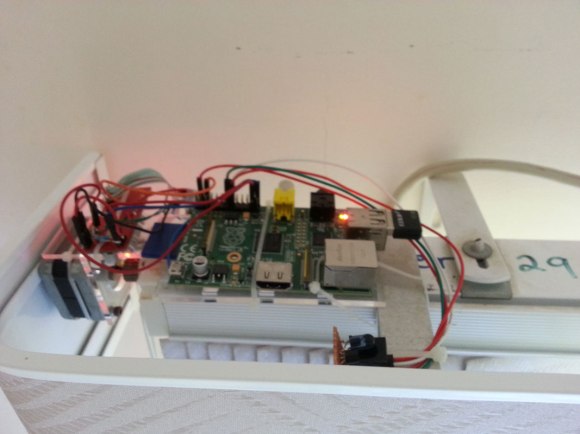
[Chris’s] bedroom has a unique setup with an air conditioning unit perched on the wall next to the top of the blinds that cover his window. Normally, to open the blinds he had to tug on a cord and operating the AC meant fiddling with a remote control. Not anymore. Now [Chris] has an all-in-one Raspberry Pi-based solution to drive both.
The build uses a stepper motor salvaged from a printer to directly drive the blinds, with a familiar-looking Easy Driver connecting it to the Pi. The motor spins the blinds’ mechanism either open or closed, though at a modest pace that’s slow enough to provide the needed torque. [Chris] added an IR diode plugged into the Pi that imitates the air conditioning unit’s remote control, and simply pointed it directly at the unit’s receiver. An inexpensive WiFi dongle gets the Pi onto the network, allowing [Chris] to interact via a custom web interface. The interface itself not only provides a couple of clickable buttons, but a cleverly-designed status image indicating the position of the blinds.
Make sure you see the video below for a demonstration and for more details on the build. This is one of the better examples of home automation devices we’ve seen recently, especially considering it actually fits the “autonomous” implications discussed in our Ask Hackaday post from a few months back—although a relatively simple automation, [Chris’s] interface does allow for operating both the blinds and the AC on a preselected schedule.
















What I want to know is, what printers have decent steppers in them like that. Anything I’ve torn down, at least inkjets just use brushed dc motors with quadrature encoder strips/discs.
And dotmatrix are like hens teeth these days. Kicked myself for throwing all my old ones out some years back.
Look for larger laser printers – the last few I have parted out use a stepper motor to feed the paper from the tray, especially printers with high capacity add-on paper trays.
Any scanner will have one small stepper motor, and any scanner with an automatic document feeder will have another, usually larger, one to drive the paper.
This is a nice project but for argument’s sake, is the project over-resourced? Would the use of a microcontroller (Arduino variant, PIC, et al) be a more cost effective and use the Raspi (a microcomputer) for higher order tasks?
If you’re not going into mass production it really doesn’t matter. And the Arduino wifi shield is way more expensive than a usb wifi dongle.
An afternoon of messing around with getting low level networking and webserver code working is worth the the $15 you might be able to save from doing this with a less powerful board..
I agree, and if you want to forgo the ‘way too many buttons’ gui, this can be done with discrete components. shocker here, I know…
Nice project!
Whats that blue thing plugged in to your Launchpad’s usb port?
It’s just a blue USB cable from DealExtreme
I bet if he turned up the current on the stepper driver he could quadruple the speed.